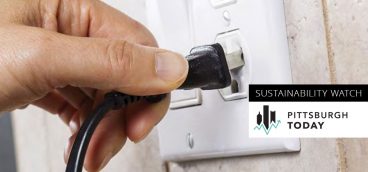
Turn on a light bulb. Run the dishwasher. Boot up the computer. Run a Google search. Somewhere, a turbine spins, a coal-laden barge docks near a power plant, a nuclear reactor harvests the bound-up energy of a uranium atom.
Electricity generation leads to the release of harmful emissions and a relentless pursuit to extract more energy from ever harder to reach or ever more dangerous parts of the globe. The world is getting hotter, and global demand for energy is expected to double by 2050. If you’re finding it harder and harder to turn the light switch on these days without feeling a little conflicted, you’re not alone. For decades now, we’ve heard the drumbeat of conservation—remember President Jimmy Carter’s sweaters? But cutting back on our electric use has proven elusive. Electricity consumption climbs by a thirsty 1 to 3 percent a year, fueled by our ever-expanding collection of laptops, DVD players, and barn-door-sized plasma screens.
But in the fall of 2008, the state legislature did something it’s never done before—it quietly passed a law requiring Pennsylvanians to cut back on electric use.
Act 129 of 2008, as it came to be called, actually requires electrical distribution companies—those senders of end-of-the-month light bills—to sell less energy. The numbers aren’t particularly eye-catching, 1 percent reduction by 2011, 3 percent by 2013. It won’t do much for those iceless polar bears or the island nation of Tuvalu, but considering that Pennsylvania had never required conservation before, ACT 129 is a rather big step. By 2013, the state will be using 4.4 million fewer megawatt hours per year. That’s the equivalent of the electricity used in 420,000 homes.
“This is a very big deal. This is not window-dressing,” says Tom Tuffey, director for the Center for Energy, Enterprise and the Environment at PennFuture, which lobbied the legislature for passage of the act. “Act 129 is the real McCoy. This is not phoney baloney.”
Consider this: Utility companies will spend more than $250 million a year implementing the conservation goalposts set by the law. (They will get part of that money back from fees added to electric bills.) If the utilities don’t get their customers to use less electricity, they’ll face up to $20 million in fines. More important, if they can’t get their customers to cut back on electric use, the state’s Public Utility Commission will do it for them. The PUC will take over the distribution companies’ energy conservation programs—currently run by outside firms the companies have hired—if conservation targets are missed. This might be the biggest environmental news you’ve never heard about.
So, why now? In a word (or two), rate caps. The state-set maximum electricity rates that utilities were allowed to charge customers are about to come off. With rates about to climb by 10 to 40 percent, the legislature is trying to get customers to shave a little from their monthly electric bills through conservation.
Of course, the environmental costs of electricity production played a factor, too. Burning coal, natural gas and petroleum to produce electricity releases greenhouse gases, which is the key component in climate change. And nuclear power, which accounts for about 20 percent of our electricity, produces radioactive waste that will be dangerous for centuries.
As the law begins to take effect, electrical distributors have started doing something few companies have ever done—persuade customers to use less of their product. After years of offering pilot projects and voluntary conservation programs, utilities are evangelizing ratepayers in the new gospel of efficiency. They’re offering rebates as incentives to get energy-efficient light bulbs, appliances, and “smart” meters into homes from Williamsport to little Washington.
“Up until they were given this mandate, the utilities resisted telling people how to save energy,” says Ann Gerace, executive director of Conservation Consultants, Inc. “They were selling it; they didn’t want people to save it. It’s like telling Macy’s not to sell clothes.”
But that’s exactly what utilities are doing, using programs with catchy names such as “Watt Watchers” (Allegheny Power) and “Watt Choices” (Duquesne Light). Duquesne Light, for instance, will buy old refrigerators for $35 and haul them away to recycle them. The electric companies are offering rebates on everything from dehumidifiers, motion-controlled occupancy sensors for light switches, and solar hot water heaters.
For businesses, Duquesne Light will pay $4 to remove an unnecessary lighting fixture, $100 for a high-efficiency copier, and up to $1,500 for restaurants that want to replace their “grill-to-order production line equipment” with a more efficient model. The rebate prices are all determined by their value in “negawatts”—the amount of electricity the utility figures to save, says Dave Defide, who is managing Watt Choices for Duquesne Light. “We are trying to get the biggest bang for the limited resources we have for the program,” Defide says. “A new refrigerator ($10 rebate) isn’t going to save as much electricity as an efficient dehumidifier ($50) or a programmable thermostat ($65).”
In addition to overall energy reduction, the power companies will have to reduce the peak demand by 4.5 percent by 2013. “Peak shaving” is a big deal in the efficiency world because these are hours of heavy demand that tax the electrical grid and consume disproportionate amounts of fuel. These are typically the hottest days of the year, when air conditioners are running full-bore. To meet this demand, generation companies fire up their smallest and least efficient power plants, which run on oil, natural gas and even wood. (It’s true—wood-powered plants are gaining popularity in New England.) Typically, the smaller the plant, the less efficient. “Natural gas turbines are very expensive to run,” says Greg Reed, director of the University of Pittsburgh’s Energy and Power Initiative and an associate professor of engineering. “It’s basically a big jet engine, and it runs about as efficiently as one.”
To reduce these peak-hour demands, the power companies will institute “time of use” pricing on some customers, by giving them the option to pay for their electricity based on the laws of supply and demand. They’ll pay more for their power at 3 p.m. than they would at 3 a.m., for instance. To use this feature, they’ll have to install a “smart meter,” which feeds real-time electric use information. Customers will actually be able to see a screen telling them where their electricity is going—the laundry room, the refrigerator, the plasma television. Power companies will also offer customers the option to have their air conditioners lowered or turned off on these peak demand days.
By putting this information in the hands of the customer, it will inevitably force them to consider how they burn their juice.
“We’ll be able to ask ourselves, ‘do we want to spend 10 cents per kilowatt hour to do our laundry at 3 in the afternoon, or do we want to do the laundry at 7 p.m., when it’s going to cost 7 cents,’” says Reed.
New York, New Jersey, California and a handful of other states have started these types of efficiency programs, with various degrees of success. California has been promoting efficiency for 20 years. “When you look at California’s demand growth, it is beginning to flatten—you can attribute a lot of that to its energy efficiency programs,” Reed says.
“Where the challenge will be is in changing the consumers’ behavior. We’re used to doing things a certain way. We’re the most advanced society in the world; we do things that are convenient for us. We’re going to have to change how we behave to have a little less convenience for a long-run benefit.”
Reed points to a smart-meter installation program in Houston as a cautionary tale. The utility, Central Point Energy, installed nearly one million smart meters in customers’ homes. The meters gave customers the option to turn their air conditioning down automatically during times of peak demand by manipulating the settings. “Only about 10 percent of all the people with smart meters changed the standard settings that came with the meter,” says Reed. “Part of that implementation is really on us as consumers to change some of our behavior.”
Fred Murphy, a professor in Temple University’s Fox School of Business and an expert in energy markets, is skeptical that energy efficiency programs relying heavily on rebates are the best way to reduce electrical consumption.
“These programs make all sorts of claims about benefits, but their real benefits aren’t clear,” says Murphy. “The transaction costs are high, and I’m not sure we’re not subsidizing a change that would have taken place anyway.”
Murphy says the best way to reduce electrical consumption is simply to make it more expensive. During the days of $4-a-gallon gas in the summer of 2008, Americans actually decreased their number of miles driven for the first time since 1980. “What we saw when gas hit $4 a gallon is high gasoline prices discourage driving.”
Alternatively, Murphy favors the creation of efficiency markets, using a principle similar to the cap-and-trade programs being proposed to curb carbon dioxide emissions. He suggests auctioning off efficiency subsidies—the company whose project would save the most electricity would win the subsidy.
“You’ve got so many millions of dollars to spend on subsidies—you’d take bids for highest kilowatt hour saved per dollar. The utility would audit the savings and award them to places that give them the best value for their subsidy dollar.”
Despite these concerns, one thing that is clear is utility companies are aggressively trying to meet their targets. Customers who are already thinking about becoming more efficient will have a greater incentive to do so.
Eat’n Park, for instance, will replace more than 350 incandescent lighting fixtures and replace them with super-efficient LED lamps. The upgrade will cost the chain $35,000 to install in 29 of its restaurants, says Andy Dunmire, vice president of design and construction. But the company decided to go ahead with it based on Duquesne Light’s promise to pay 11 cents for every dollar of electricity the company will save. The lamps will save the company $14,000 a year in electric costs, so Duquesne Light will kick in an additional $1,500 toward the cost of the light bulbs.
“It almost cuts your payback time in half,” Dunmire says. “For a lighting project that typically would have a five-year payback, a three-year payback is a whole lot more palatable for businesses.” Eat’n Park is also applying for a rebate for a geothermal heat transfer system in a new restaurant in Fox Chapel, which will be Pittsburgh’s first LEED-certified restaurant. The unit will take waste heat from its freezer compressor and use it to pre-heat water flowing into its hot water tank.
These types of energy retrofits are why some see the law as providing the impetus for an “efficiency boom” in the state. Tuffey of PennFuture says private investment, combined with what the companies will spend on efficiency upgrades, will create a $1 billion “efficiency market” in the state.
For a business like Eat’n Park, being environmentally friendly is certainly “the right thing to do,” Dunmire says, but the reason it’s making its upgrades has more to do with money.
“There’s so much low hanging fruit out there as far as green initiatives that make better economic sense. The payback is there. If you have the time to study it, and you have the capital reserves to do it, it makes great economic sense for a business.”
Ultimately, that’s what the utilities are hoping to do—make the decision to use less electricity an easy one for customers.





